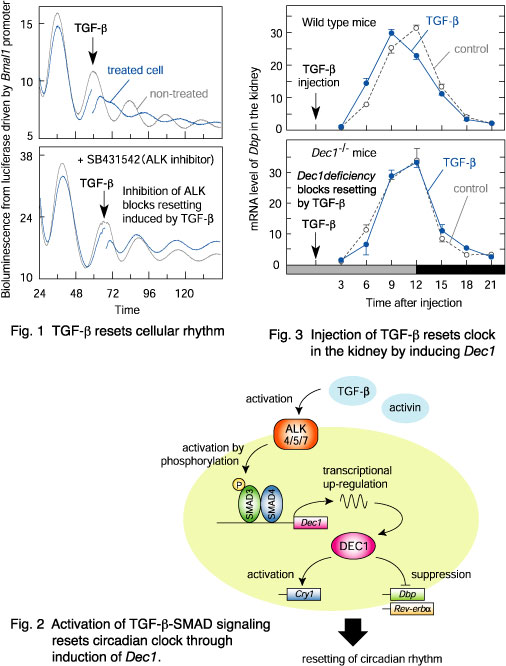Activation of TGF-ß/activin signalling resets the circadian clock through rapid induction of Dec1 transcripts
A variety of living organisms shows daily rhythms in behaviors and physiological events, which persist under constant conditions with the intrinsic period length of approximately 24 h under the control of circadian clocks. In mammals, the central clock is localized in hypothalamic suprachasmatic nuclei, while many other tissues also retain self-sustainable oscillators called peripheral clocks. All these cell-autonomous circadian clocks are reset for synchronization by time cues, such as light (for the central clock) and many non-photic signals (for the peripheral clocks). In contrast to Per gene-dependent photic resetting of the central clock, little is known about the reset signaling for peripheral clocks. Here Kon (a Research Assistant supported by the global COE) and others found that TGF-ß or activin resets the cellular bioluminescent rhythm driven by Bmal promoter through activation of activin receptor-like kinase (ALK) in cultured Rat-1 fibroblasts, a useful model of the peripheral clock (Fig. 1). The resetting was mediated by an immediate-early induction of Dec1, a gene whose physiological role in clockwork has been enigmatic. The acute Dec1 induction was prerequisite for the ALK-mediated resetting, and the up-regulation was dependent on SMAD3 which was phosphorylated by ALK for activation in response to the resetting stimuli (Fig. 2). Intraperitoneal injection of TGF-ß into wild-type or Dec1-deficient mice demonstrated that Dec1 plays an essential role for phase-shift of clock gene expression in the kidney and adrenal gland (Fig. 3). These results highlight ALK-SMAD3-Dec1 signaling as a novel input pathway in the mammalian molecular clockwork.
Program member
Yoshitaka Fukada (Department of Biophysics and Biochemistry, Graduate School of Science)

